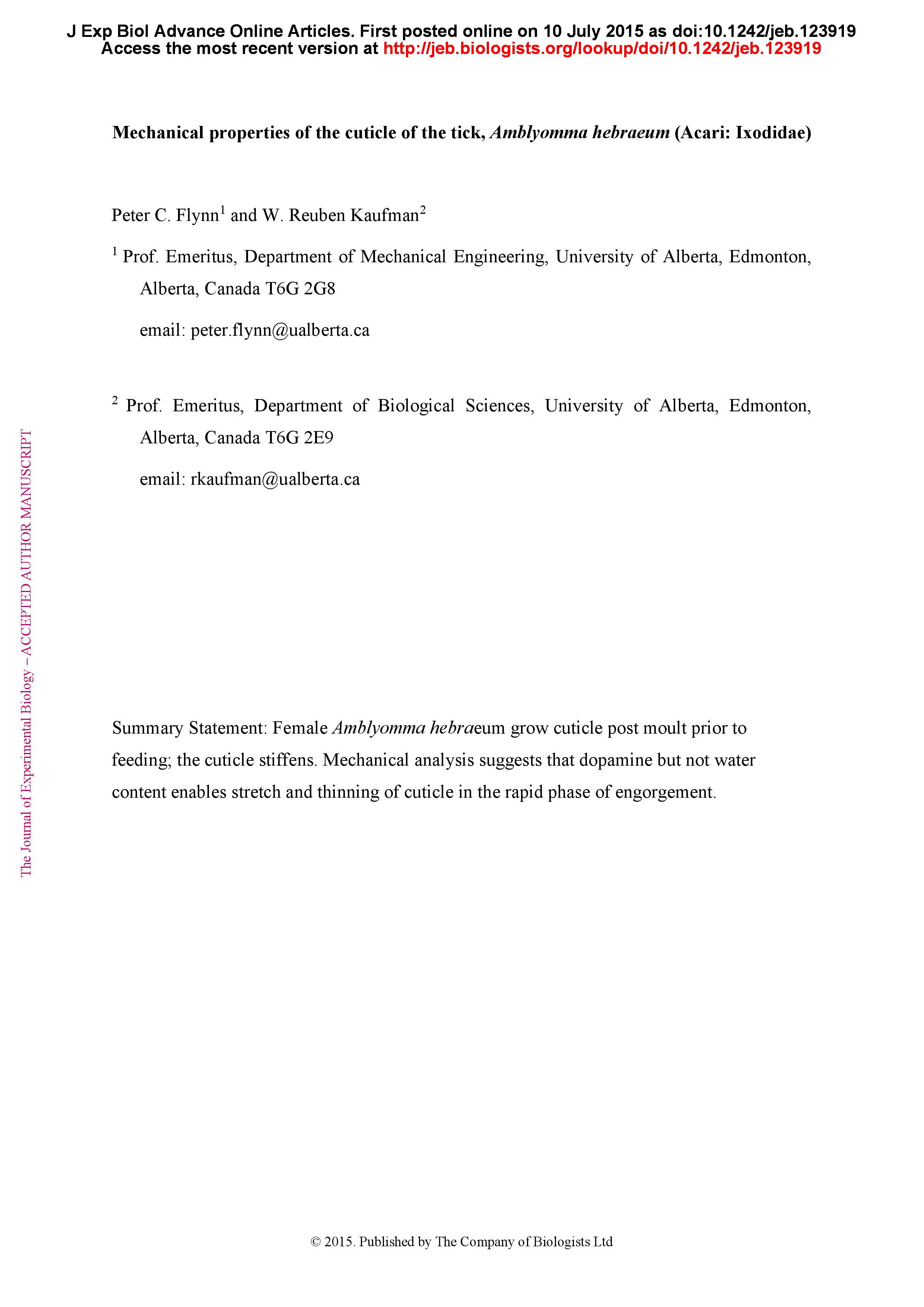Female ticks of the family Ixodidae increase their weight up to 100-fold during the 7-10 day feeding period. We determined the material properties of the alloscutal cuticle of female Amblyomma hebraeum from the time of moulting through full engorgement. The material properties of the cuticle were evaluated by a Kelvin-Voigt analysis of compliance determined from the stretch of loops of cuticle under stress. There was a 3-fold increase in cuticle dry weight during the first 3 weeks post moult, during which the ductility and stiffness of the cuticle increased substantially. Under stress, cuticle displayed time-dependent stretch, with a plastic (non-recoverable) and viscoelastic (recoverable) component. Plastic deformation was reasonably constant in the range of 10 to 15% over a wide range of induced stress above ∼0.6 MPa. The plastic component of tick alloscutal cuticle was about five to ten times higher than that of unsclerotized insect cuticle. Tick cuticle is also far more ductile than unsclerotized insect cuticle. Material properties of the cuticle did not change significantly as a function of cuticular water content over the normal range throughout the feeding cycle (13-37% wet weight). Injected dopamine (DA) reduced one measure of the viscosity of cuticle by 38%. Plastic deformability of cuticle was reduced by 70% after an in vitro stretch, but restored in fully engorged ticks, and in in-vitro stretched loops by treatment with DA and reduced pH. Thinning of cuticle by half during the rapid phase of engorgement requires plastic deformation (irreversible strain) in two orthogonal dimensions in excess of 40%. Treatment with DA increased plastic deformation and enabled extensibility (strain at the point of rupture) above 40%.
Mechanical properties of the cuticle of the tick, Amblyomma hebraeum (Acari: Ixodidae)
Currently Viewing Accepted Manuscript - Newer Version Available
- Split-screen
- Views Icon Views
- Open the PDF for in another window
-
Article Versions Icon
Versions
- Version of Record 01 September 2015
- Accepted Manuscript 01 January 2015
- Share Icon Share
-
Tools Icon
Tools
- Search Site
Peter C. Flynn, W. Reuben Kaufman; Mechanical properties of the cuticle of the tick, Amblyomma hebraeum (Acari: Ixodidae). J Exp Biol 2015; jeb.123919. doi: https://doi.org/10.1242/jeb.123919
Download citation file:
Advertisement
2023 JEB Outstanding Paper Prize shortlist and winner

The JEB Editors are delighted to announce the shortlisted authors for the 2023 JEB Outstanding Paper Prize. Read the winning paper - Tiny spies: mosquito antennae are sensitive sensors for eavesdropping on frog calls - by Hoover Pantoja-Sanchez and Brian Leavell from Ximena Bernal's lab at Purdue University, USA.
JEB Science Communication Workshop for ECRs

If you’re an early-career researcher interested in science communication and are attending the SEB Annual Conference in Prague this summer, come a day early and join the JEB Editors at a sci comm workshop to learn the key writing skills needed to promote your research to a broad audience beyond your peers (1 July at 14.30-17.30). Places are limited to 24 attendees, and applicants should apply through the SEB registration page by 30 April 2024.
Bridging the gap between controlled conditions and natural habitats in understanding behaviour

Novel technologies enable behavioural experiments with non-model species, in naturalistic habitats and with underexplored behaviours. In their Commentary, Scholz and colleagues discuss how to obtain a deeper understanding of the natural ecology and lifestyle of study animals.
Beluga metabolic measures could help save species

To help save animals from extinction, it’s important to understand what each species needs to survive. This led Jason John et al. to measure the metabolic rates of captive belugas to develop a ‘fish calculator’ showing that the whales need to eat ~23 salmon per day.
ECR Workshop on Positive Peer Review

Are you an ECR looking for tips on how to write concise, astute and useful manuscript reviews? If so, join the JEB Editors at a 2-hour JEB-sponsored Workshop on Positive Peer Review at the Canadian Society of Zoologists annual meeting in Moncton on 9 May 2024 at 13.00-15.00. There are 25 spaces for ECRs and selection is first come, first serve. To sign up, check the ECR Workshop box when you register for the CSZ meeting.



